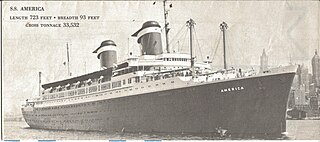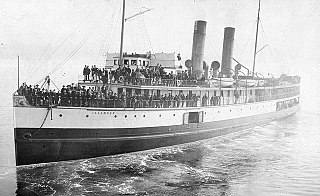Citations
- ↑ "Lusitania wrecked off Newfoundland coast; Passengers numbering more than 350 escape in lifeboats" (PDF). The New York Times. 27 June 1901. Retrieved 6 December 2016.
Numerous vessels have borne the name Lusitania, named after Lusitania , an ancient Roman province corresponding to most of modern Portugal. The most famous was:
Other vessels include:

Newport News Shipbuilding (NNS), a division of Huntington Ingalls Industries, is the sole designer, builder, and refueler of aircraft carriers and one of two providers of submarines for the United States Navy. Founded as the Chesapeake Dry Dock and Construction Co. in 1886, Newport News Shipbuilding has built more than 800 ships, including both naval and commercial ships. Located in the city of Newport News, its facilities span more than 550 acres (2.2 km2).

Kaiser Wilhelm der Grosse was a German transatlantic ocean liner named after Wilhelm I, German Emperor, the first monarch of the German Empire.

An ocean liner is a type of passenger ship primarily used for transportation across seas or oceans. Ocean liners may also carry cargo or mail, and may sometimes be used for other purposes. Only one ocean liner remains in service today.

RMS Lusitania was a Lusitania-Class ocean liner that was launched by the Cunard Line in 1906 and held the Blue Riband appellation for the fastest Atlantic crossing in 1908. It was briefly the world's largest passenger ship until the completion of the Mauretania three months later. She was sunk on her 202nd trans-Atlantic crossing, on 7 May 1915, by a German U-boat 11 miles (18 km) off the southern coast of Ireland, killing 1,199 passengers and crew.

SS Lusitania was a Portuguese twin-screw ocean liner of 5,557 tons, built in 1906 by Sir Raylton Dixon & Co, and owned by Empresa Nacional de Navegação, of Lisbon.

RMS Mauretania was a Lusitania-Class ocean liner designed by Leonard Peskett and built by Wigham Richardson and Swan Hunter on the River Tyne, England for the British Cunard Line, launched on the afternoon of 20 September 1906. She was the world's largest ship until the launch of RMS Olympic in 1910. Mauretania became a favourite among her passengers. She captured the eastbound Blue Riband on her maiden return voyage in December 1907, then claimed the westbound Blue Riband for the fastest transatlantic crossing during her 1909 season. She held both speed records for 20 years.

SS America was an ocean liner and cruise ship built in the United States in 1940 for the United States Lines and designed by the noted American naval architect William Francis Gibbs. It carried many names in the 54 years between its construction and its 1994 wreck: SS America ; troop transport USS West Point; and SS Australis, Italis, Noga, Alferdoss, and American Star. It served most notably in passenger service as America and the Greek-flagged Australis.
SS America may refer to:

SS Valencia was an iron-hulled passenger steamer built for the Red D Line for service between Venezuela and New York City. She was built in 1882 by William Cramp and Sons, one year after the construction of her sister ship Caracas. She was a 1,598-ton vessel, 252 feet (77 m) in length. In 1897, Valencia was deliberately attacked by the Spanish cruiser Reina Mercedes off Guantanamo Bay, Cuba. The next year, she became a coastal passenger liner on the U.S. West Coast and served periodically in the Spanish–American War as a troopship to the Philippines. Valencia was wrecked off Cape Beale, which is near Clo-oose, on the west coast of Vancouver Island, British Columbia, on 22 January 1906. As her sinking killed 100 people, some classify the wreck of Valencia as the worst maritime disaster in the "Graveyard of the Pacific", a famously treacherous area off the southwest coast of Vancouver Island.

The SS Islander was a 1519-ton, 240-foot (73 m) steel hull, schooner-rigged twin-screw steamer, built in Scotland in 1888, and owned and operated by the Canadian-Pacific Navigation Company.
At least six steamships have been called Orizaba:
SS California may refer to the following ships:

A four-funnel liner, also known as a four-stacker, is an ocean liner with four funnels.

The "Big Four" were a quartet of early-20th-century 20,000-ton ocean liners built by the Harland & Wolff shipyard for the White Star Line, to be the largest and most luxurious ships afloat. The group consisted of Celtic, Cedric, Baltic and Adriatic.
SS Oregon may refer to the following steamships:

The SS Carolina was a 380-foot-long (120 m) passenger liner; it was one of six vessels sunk on a single day during World War I by the German submarine U-151 on "Black Sunday". The wreck was rediscovered in 1995 by wreck divers John Chatterton and John Yurga.
Several steamships have borne the name Main:
SS Mira may refer to: